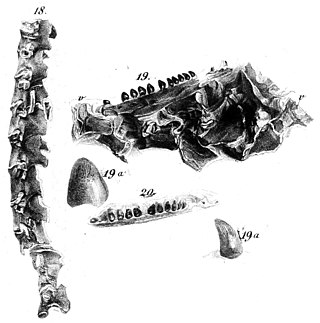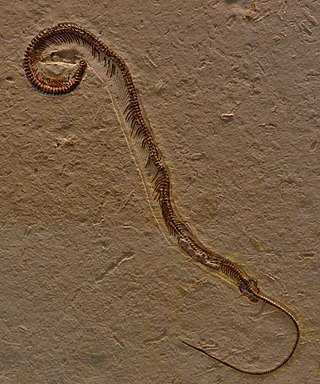
Ophidia is a group of squamate reptiles including modern snakes and reptiles more closely related to snakes than to other living groups of lizards.

Andesaurus is a genus of basal titanosaurian sauropod dinosaur which existed during the middle of the Cretaceous Period in South America. Like most sauropods, belonging to one of the largest animals ever to walk the Earth, it would have had a small head on the end of a long neck and an equally long tail.

Tianzhenosaurus is a monospecific genus of ankylosaurid dinosaur from the Shanxi Province that lived during the Late Cretaceous in what is now the Huiquanpu Formation. Tianzhenosaurus may represent a junior synonym of Saichania, an ankylosaurine known from the Barun Goyot and Nemegt Formation.

Aigialosauridae is a family of Late Cretaceous semiaquatic pythonomorph lizards closely related to the mosasaurs. Regarded by some paleontologists as a distinct monophyletic group and by others as an adaptive grade within the basal mosasauroids, recent molecular and morphological data suggests that they are the oldest known members of the lineage leading to the mosasaurs.

Dallasaurus is a basal mosasauroid from the Upper Cretaceous of North America. Along with Russellosaurus, Dallasaurus is one of the two oldest mosasauroid taxa currently known from North America. It is also one of the smallest known mosasaurines, measuring approximately 1 m (3.3 ft) in length.

Adriosaurus is an extinct genus of squamate which lived in what is now Slovenia and other parts of Europe during the Late Cretaceous. It was a small, snake-like reptile, with the type species Adriosaurus suessi measuring up to 30 cm (12 in) in length. Adriosaurus represents the first occurrence of vestigial limbs in fossil lizards, having lost its manus and forearm completely in order to elongate its axial skeleton. These unique anatomical features led to discussions of the evolutionary patterns of limb reduction in Squamata.

Dolichosaurus is an extinct genus of marine squamate of the Upper Cretaceous Cenomanian chalk deposits of England. It is a member of the family Dolichosauridae. It was a small reptile measuring 0.5–1 m (1.6–3.3 ft) long. It had an elongate neck resulting from an increased number of cervical vertebrae.

Eupodophis is an extinct genus of snake from the Late Cretaceous period. It has two small hind legs and is considered a transitional form between Cretaceous lizards and limbless snakes. The feature, described as vestigial, was most likely useless to Eupodophis. The type species Eupodophis descouensi was named in 2000 and resides now in the paleontology section of the Mim Museum in Beirut, Lebanon. The specific name is dedicated to the French naturalist Didier Descouens.

Mosasauroidea is a superfamily of extinct marine lizards that existed during the Late Cretaceous. Basal members of this group consist of small semiaquatic forms with terrestrial limbs ("plesiopedal"), while laters members include larger fully aquatic paddle-limbed ("hydropedal") forms commonly known as mosasaurs. These were traditionally grouped within their own separate families, the Aigialosauridae and Mosasauridae respectively. However, phylogenetic studies have since found plesiopedal mosasauroids to be a non-monophyletic group, with some taxa nestled within the mosasaurids. Daniel Madzia and Andrea Cau in 2017 defined Mosasauroidea as "the most inclusive clade containing Mosasaurus hoffmannii and Aigialosaurus dalmaticus, but not Dolichosaurus longicollis, Adriosaurus suessi, or Pontosaurus lesinensis".

Tethysaurus is an extinct genus of tethysaurine mosasauroid from the Early Turonian period. The only species is Tethysaurus nopcsai.

Carsosaurus is a genus of extinct amphibious reptiles, in the mosasaur superfamily, containing only the species Carsosaurus marchesetti. It is known from a single individual that lived during the Upper Cretaceous in what is now Slovenia. The specimen is well-preserved, containing many different bones as well as some skin impressions and sternal cartilage. While more remains are needed to be certain, it is generally thought to belong to the Aigialosauridae. In life, it was an amphibious creature that spent most of its time on land, although its later relatives would become fully aquatic.
Carsothrissops is an extinct genus of marine ray-finned fish that lived during the Cenomanian. It contains a single species, C. delorenzi from Komen, Slovenia.

Aigialosaurus is an extinct genus of Late Cretaceous marine or semiaquatic lizard classified as part of the family Aigialosauridae within the Mosasauroidea. Exclusively found in deposits of Cenomanian age near Hvar, Croatia, the genus contains one valid species, A. dalmaticus. According to recent molecular and morphological data, Aigialosaurus is the oldest known member of the lineage leading to large Cretaceous marine reptiles called mosasaurs, a group most closely related to snakes among living squamates. It was a relatively small reptile with a complete specimen measuring 65 cm (2.13 ft) long.

Opetiosaurus is an extinct genus of Late Cretaceous marine or semiaquatic lizard classified as part of the family Aigialosauridae within the Mosasauroidea. Exclusively found in deposits of Cenomanian age near Hvar, Croatia, the genus contain one valid species, O. bucchichi. It was a small reptile measuring 1 metre (3.3 ft) long.

Tianyuraptor is a genus of short-armed dromaeosaurid dinosaur that lived during the Early Cretaceous, about 122 million years ago. Its remains have been found in western Liaoning, China. It was similar to other dromaeosaurids found in Liaoning, with the exception of being somewhat more primitive. The type specimen, formally named in 2009, shows features not seen in previously known Northern Hemisphere (Laurasian) dromaeosaurids, but present in Southern Hemisphere (Gondwanan) species and early birds. Because of this, the scientists who first studied Tianyuraptor described it as a "transitional species", bridging the gap between northern and southern types of dromaeosaurid. Tianyuraptor also differs from previously known dromaeosaurids in that it possesses a relatively small furcula ("wishbone"), and unusually short forelimbs.

(Georg) Andreas von Kornhuber was an Austrian naturalist and paleontologist.

Coniasaurus is an extinct genus of Late Cretaceous marine squamates that range in age from Cenomanian to Santonian. It was first described by Richard Owen in 1850 from lower Cenomanian chalk deposits in South East England (Sussex). Two species have been described from this genus: C. crassidens, known from Cenomanian to Santonian deposits from South East England, Germany and North America, and C. gracilodens from the Cenomanian of southeast England.

Tetrapodophis is an extinct genus of lizard from the Early Cretaceous (Aptian) aged Crato Formation of Brazil. It has an elongated snake-like body, with four disproportionately short limbs.

Dolichosauridae is a family of Cretaceous aquatic lizards. They are widely considered to be the earliest and most primitive members of Mosasauria, though some researchers have recovered them as more closely related to snakes.


















